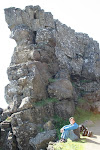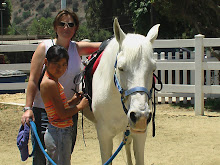April 20, 2009
Tools for Training
Speaking of dogs that pull (see below: "Durham Dog Training"), one of the best dog training tools I've come across recently are headcollars designed specifically for reducing pulling. These collars were designed by a horse trainer who realized that the best way to lead an animal is from the head, not the throat or neck area. Large, powerful animals like horses and camels can be safely led and directed with head halters. Why not dogs?
Some dogs pull because of inadequate training, but many dogs pull as a result of their breed. Huskies, Malamutes, Bully breeds, Akitas, and even hunting dogs tend to pull as a result of instinct, desire, and an overwhelming need to move forward and pursue prey. So, rather than getting into a pulling match or causing pain or even injury to a dog's neck, why not try a different kind of collar? I've used the Halti brand collar, and it works well, but some dogs can get out of it or pull it off with their paws. I've heard good things about the Gentle Leader Headcollar, and will field test it soon.
Whatever headcollar you choose, don't forget to slowly acclimatize your dog to the new system. Most dogs will not feel comfortable right away with a band around their nose, but with treats and repetition, they will get used to it! The beauty of these collars is that they are self-correcting: each time a dog pulls, it feels pressure across it's nose and the back of its neck, and reacts by slowing down to release the pressure. This is a completely humane, pain-free system that mimics behavior in the wild. Wolves will gently put pressure on the snout and back of the neck of any pack member that is asserting too much leadership, like trying to pull ahead of the pack! Most dogs will respond to the pressure by stopping or slowing down, and will learn to stop pulling without being forced, choked, or yanked.
No matter what type of collar or equipment you use, don't forget to keep training your dog!Reward the non-pulling behavior with positive reinforcement (allow sniffing, moving forward, praise, treats) and NEVER reward pulling. Allowing your dog to pull is self-rewarding to the dog. In other words, each and every time a dog pulls and is allowed to sniff or keep walking, the dog is getting a reward for pulling. Remember to stop and do not move forward unless and until the dog is not pulling on the leash or charging ahead.
Train your dog with repetition, positive reinforcement and patience. You will be rewarded with a happy, healthy, cooperative member of the pack. Enjoy!
Some dogs pull because of inadequate training, but many dogs pull as a result of their breed. Huskies, Malamutes, Bully breeds, Akitas, and even hunting dogs tend to pull as a result of instinct, desire, and an overwhelming need to move forward and pursue prey. So, rather than getting into a pulling match or causing pain or even injury to a dog's neck, why not try a different kind of collar? I've used the Halti brand collar, and it works well, but some dogs can get out of it or pull it off with their paws. I've heard good things about the Gentle Leader Headcollar, and will field test it soon.
Whatever headcollar you choose, don't forget to slowly acclimatize your dog to the new system. Most dogs will not feel comfortable right away with a band around their nose, but with treats and repetition, they will get used to it! The beauty of these collars is that they are self-correcting: each time a dog pulls, it feels pressure across it's nose and the back of its neck, and reacts by slowing down to release the pressure. This is a completely humane, pain-free system that mimics behavior in the wild. Wolves will gently put pressure on the snout and back of the neck of any pack member that is asserting too much leadership, like trying to pull ahead of the pack! Most dogs will respond to the pressure by stopping or slowing down, and will learn to stop pulling without being forced, choked, or yanked.
No matter what type of collar or equipment you use, don't forget to keep training your dog!Reward the non-pulling behavior with positive reinforcement (allow sniffing, moving forward, praise, treats) and NEVER reward pulling. Allowing your dog to pull is self-rewarding to the dog. In other words, each and every time a dog pulls and is allowed to sniff or keep walking, the dog is getting a reward for pulling. Remember to stop and do not move forward unless and until the dog is not pulling on the leash or charging ahead.
Train your dog with repetition, positive reinforcement and patience. You will be rewarded with a happy, healthy, cooperative member of the pack. Enjoy!
Subscribe to:
Post Comments (Atom)
.jpg)







No comments:
Post a Comment